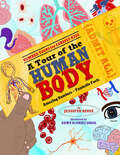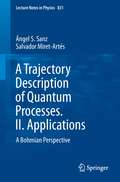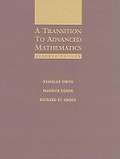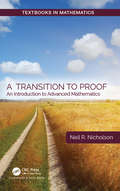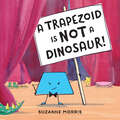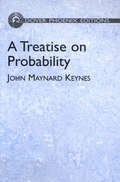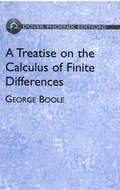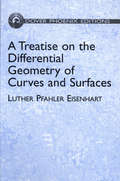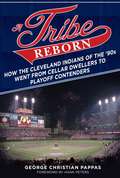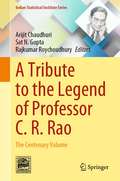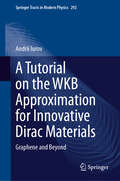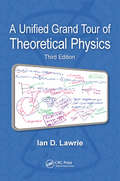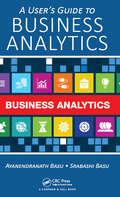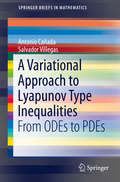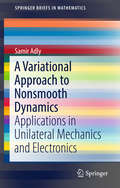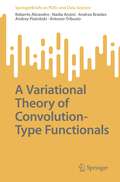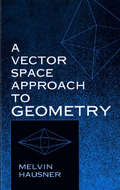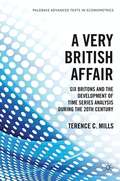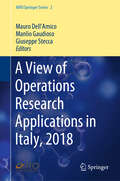- Table View
- List View
A Tour of the Calculus
by David BerlinskiIn its largest aspect, the calculus functions as a celestial measuring tape, able to order the infinite expanse of the universe. Time and space are given names, points, and limits; seemingly intractable problems of motion, growth, and form are reduced to answerable questions. Calculus was humanity's first attempt to represent the world and perhaps its greatest meditation on the theme of continuity. Charts and graphs throughout.From the Hardcover edition.
A Tour of the Human Body: Amazing Numbers--Fantastic Facts (Number Tours for Curious Kids)
by Jennifer BerneJennifer Berne takes children on a tour of the human body to reveal the wonders of how it works -- with some astonishing numbers and fascinating facts along the way.From our eyes to our toes, kids will find out what makes the human body tick. They&’ll discover that our hearts beat 100,000 times a day, which equals 36 MILLION times a year. And that our tongue&’s 8,000 taste buds can detect only 5 flavors. And that we have 60,000 miles of blood vessels, enough to circle the world more than twice!With such remarkable facts and numbers, and vivid informative illustrations by Dawn DeVries Sokol, this book takes your child on an entertainingly educational journey through the wonders of the human body.
A Trajectory Description of Quantum Processes. II. Applications: A Bohmian Perspective (Lecture Notes in Physics #831)
by Ángel S. Sanz Salvador Miret-ArtésTrajectory-based formalisms are an intuitively appealing way of describing quantum processes because they allow the use of "classical" concepts. Beginning as an introductory level suitable for students, this two-volume monograph presents (1) the fundamentals and (2) the applications of the trajectory description of basic quantum processes. This second volume is focussed on simple and basic applications of quantum processes such as interference and diffraction of wave packets, tunneling, diffusion and bound-state and scattering problems. The corresponding analysis is carried out within the Bohmian framework. By stressing its interpretational aspects, the book leads the reader to an alternative and complementary way to better understand the underlying quantum dynamics.
A Transition to Advanced Mathematics (7th Edition)
by Douglas Smith Maurice Eggen Richard St. AndreThe main goal of the book is to improve the student's ability to think and write in a mature mathematical fashion and to provide a solid understanding of the material most useful for advanced courses.
A Transition to Proof: An Introduction to Advanced Mathematics (Textbooks in Mathematics)
by Neil R. NicholsonA Transition to Proof: An Introduction to Advanced Mathematics describes writing proofs as a creative process. There is a lot that goes into creating a mathematical proof before writing it. Ample discussion of how to figure out the "nuts and bolts'" of the proof takes place: thought processes, scratch work and ways to attack problems. Readers will learn not just how to write mathematics but also how to do mathematics. They will then learn to communicate mathematics effectively. The text emphasizes the creativity, intuition, and correct mathematical exposition as it prepares students for courses beyond the calculus sequence. The author urges readers to work to define their mathematical voices. This is done with style tips and strict "mathematical do’s and don’ts", which are presented in eye-catching "text-boxes" throughout the text. The end result enables readers to fully understand the fundamentals of proof. Features: The text is aimed at transition courses preparing students to take analysis Promotes creativity, intuition, and accuracy in exposition The language of proof is established in the first two chapters, which cover logic and set theory Includes chapters on cardinality and introductory topology
A Trapezoid Is Not a Dinosaur!
by Suzanne MorrisIn this wildly amusing, unconventional shape concept book, Trapezoid is here to declare that he's a shape, too. He's NOT a type of dinosaur!Shape up, shapes! Triangle is hosting auditions for all the best shapes to be in his play. Circle, Square, and Star each get a part. But Trapezoid just doesn't "fit in." Is he even a shape? The others think he sounds like a type of dinosaur. Determined to show off his usefulness, Trapezoid tries to act like the other shapes, to no avail. Eventually, though, Trapezoid celebrates his own distinct shape properties in order to become part of the performance.
A Treatise on Probability
by John Maynard KeynesWith this treatise, an insightful exploration of the probabilistic connection between philosophy and the history of science, John Maynard Keynes (1883-1946) breathed new life into studies of both disciplines. Originally published in 1921, the famous economist's most important mathematical work represented a significant contribution to the theory regarding the logical probability of propositions. Keynes effectively dismantled the classical theory of probability, launching what has since been termed the "logical-relationist" theory. In so doing, he explored the logical relationships between classifying a proposition as "highly probable" and as a "justifiable induction."A Treatise on Probability argues that probability is a matter of logic, which renders it objective: a statement involving probability relations possesses a truth value independent of opinion. Keynes demonstrates that if a hypothesis has even the smallest finite probability, it can be transformed into certainty by a sufficient number of observations. This is his attempt to overcome Humean skepticism by asserting that theoretically grounded hypotheses need only exhibit finite probability to form the basis of science and rational action. Another key idea discussed in A Treatise on Probability is that probability relations constitute only a partially ordered set in the sense that two probabilities cannot necessarily always be compared. Keynes further maintains that probability is a basic concept that cannot be reduced to other concepts.
A Treatise on the Calculus of Finite Differences
by George BooleWritten by a great English mathematician, this classic text begins with the differences of elementary functions and explores interpolation, mechanical quadrature, finite integration, and the summation of series. Several useful tests for the convergence and divergence of series are developed, as is a method for finding the limits of error in series expansions. The latter half of the book discusses difference-equations, including linear, mixed, and partial difference-equations, and concludes with applications to problems in geometry and optics. The text pays particular attention to the connection of the calculus of finite differences with the differential calculus, and more than 200 problems appear in the text (some with solutions). Unabridged republication of the classic 1872 edition.
A Treatise on the Differential Geometry of Curves and Surfaces (Dover Books on Mathematics)
by Luther Pfahler EisenhartCreated especially for graduate students, this introductory treatise on differential geometry has been a highly successful textbook for many years. Its unusually detailed and concrete approach includes a thorough explanation of the geometry of curves and surfaces, concentrating on problems that will be most helpful to students. 1909 edition.
A Triangle for Adaora: An African Book of Shapes
by Ifeoma OnyefuluWhen Adaora's cousin promises to find a triangle for her, he doesn't realize how difficult the task will be. As they search in and around their African village, the cousins encounter all different kinds of shapes, including heart-shaped leaves, round elephant drums, and crescent-shaped plantains. Other books by this author are available in this library.
A Tribe Reborn: How the Cleveland Indians of the ?90s Went from Cellar Dwellers to Playoff Contenders
by Hank Peters George Christian PappasFor almost fifty years, the Cleveland Indians were a joke. They had won the 1948 World Series with one of the greatest teams of all time, but had not been to the playoffs since 1954 (losing to the New York Giants in the World Series). Even the Major League movies poked fun at their inadequacy. That all changed in the 1990s, when the Indians became one of the most dominant teams of the decade.A Tribe Reborn tells the story of a failing franchise, from “The Mistake by the Lake” to “The Curse of Rocky Colavito,” and how a laughingstock team that was on the verge of relocating changed its ways to become a dominant franchise. With the building of the state-of-the-art Jacobs Field (which the Indians sold out a record 455 consecutive games, from 1995–2001) to changes in how their scouting, front office, and locker room were run, the team that nobody cared about became front-page news across the country. With interviews from Jim Thome, Omar Vizquel, Mike Hargrove, John Hart, and many more, A Tribe Reborn is a fantastic look inside how a losing franchise changed its ways to become a perennial powerhouse. While the Indians of the ’90s never won a World Series (appearing twice in 1995 and 1997), they are still remembered for their hard play, amazing talent, and rabid fan base.
A Tribute to the Legend of Professor C. R. Rao: The Centenary Volume (Indian Statistical Institute Series)
by Arijit Chaudhuri Sat N. Gupta Rajkumar RoychoudhuryThis book includes speeches given during five seminar sessions held in honor of Prof. C. R. Rao, on his 100th year. This book also contains a few write-ups touching on the diverse aspects of this august personality. The chapters pay tribute to Prof. C. R. Rao, the Padma Vibhushan awardee, by discussing his life and contributions to the field of statistics. The book also includes a chapter by the Abel Prize winner Prof. S. R. Varadhan who happened to successfully complete his Ph.D. under the guidance of Prof. C. R. Rao.
A Tutorial on the WKB Approximation for Innovative Dirac Materials: Graphene and Beyond (Springer Tracts in Modern Physics #292)
by Andrii IurovThis textbook serves to supplement existing quantum mechanics courses with the WKB (Wentzel–Kramers–Brillouin) theory for recently discovered Dirac materials, such as graphene, a dice lattice, and alpha-T3 materials. This includes finding the semiclassical wave function, coordinate-dependent momentum, semiclassical action, the complete set of transport equations, and applicability conditions for the approximation. The discovery of graphene and its unique electronic behavior has transformed research in condensed matter physics over the last 10-15 years, but core curriculum in standard graduate-level physics courses still does not reflect these new developments and this book intends to close this gap. With a clear focus on various types of Dirac Hamiltonians, the multidimensional theory is only a small part of the book. The derivation of the WKB equations for novel Dirac materials and their applications to electron tunneling, turning points and classically forbidden regions, resonances and localized states, and many other crucial physical problems are methodically presented. This textbook aims to expand the existing approach to presenting the WKB approximation and covers recent developments in its applications. This book also includes many informative graphics, as well as problems and exercises with hints at the end of each chapter. Additional detailed mathematical derivations, as well as code in Mathematica, are added throughout the whole book. Ideal for graduate students and researchers in condensed matter physics, this textbook serves as a modern guide for learning the WKB theory.
A Unified Grand Tour of Theoretical Physics
by Ian D. LawrieA Unified Grand Tour of Theoretical Physics invites its readers to a guided exploration of the theoretical ideas that shape our contemporary understanding of the physical world at the fundamental level. Its central themes, comprising space-time geometry and the general relativistic account of gravity, quantum field theory and the gauge theories of
A Universal Construction for Groups Acting Freely on Real Trees
by Ian Chiswell Thomas MüllerThe theory of R-trees is a well-established and important area of geometric group theory and in this book the authors introduce a construction that provides a new perspective on group actions on R-trees. They construct a group RF(G), equipped with an action on an R-tree, whose elements are certain functions from a compact real interval to the group G. They also study the structure of RF(G), including a detailed description of centralizers of elements and an investigation of its subgroups and quotients. Any group acting freely on an R-tree embeds in RF(G) for some choice of G. Much remains to be done to understand RF(G), and the extensive list of open problems included in an appendix could potentially lead to new methods for investigating group actions on R-trees, particularly free actions. This book will interest all geometric group theorists and model theorists whose research involves R-trees.
A User's Guide to Business Analytics
by Ayanendranath Basu Srabashi BasuA User's Guide to Business Analytics provides a comprehensive discussion of statistical methods useful to the business analyst. Methods are developed from a fairly basic level to accommodate readers who have limited training in the theory of statistics. A substantial number of case studies and numerical illustrations using the R-software package are provided for the benefit of motivated beginners who want to get a head start in analytics as well as for experts on the job who will benefit by using this text as a reference book. The book is comprised of 12 chapters. The first chapter focuses on business analytics, along with its emergence and application, and sets up a context for the whole book. The next three chapters introduce R and provide a comprehensive discussion on descriptive analytics, including numerical data summarization and visual analytics. Chapters five through seven discuss set theory, definitions and counting rules, probability, random variables, and probability distributions, with a number of business scenario examples. These chapters lay down the foundation for predictive analytics and model building. Chapter eight deals with statistical inference and discusses the most common testing procedures. Chapters nine through twelve deal entirely with predictive analytics. The chapter on regression is quite extensive, dealing with model development and model complexity from a user’s perspective. A short chapter on tree-based methods puts forth the main application areas succinctly. The chapter on data mining is a good introduction to the most common machine learning algorithms. The last chapter highlights the role of different time series models in analytics. In all the chapters, the authors showcase a number of examples and case studies and provide guidelines to users in the analytics field.
A User's Guide to Measure Theoretic Probability
by David PollardThis book grew from a one-semester course offered for many years to a mixed audience of graduate and undergraduate students who have not had the luxury of taking a course in measure theory. The core of the book covers the basic topics of independence, conditioning, martingales, convergence in distribution, and Fourier transforms. In addition there are numerous sections treating topics traditionally thought of as more advanced, such as coupling and the KMT strong approximation, option pricing via the equivalent martingale measure, and the isoperimetric inequality for Gaussian processes. The book is not just a presentation of mathematical theory, but is also a discussion of why that theory takes its current form. It will be a secure starting point for anyone who needs to invoke rigorous probabilistic arguments and understand what they mean.
A Variational Approach to Lyapunov Type Inequalities: From ODEs to PDEs (SpringerBriefs in Mathematics #0)
by Antonio Cañada Salvador VillegasThis book highlights the current state of Lyapunov-type inequalities through a detailed analysis. Aimed toward researchers and students working in differential equations and those interested in the applications of stability theory and resonant systems, the book begins with an overview Lyapunov's original results and moves forward to include prevalent results obtained in the past ten years. Detailed proofs and an emphasis on basic ideas are provided for different boundary conditions for ordinary differential equations, including Neumann, Dirichlet, periodic, and antiperiodic conditions. Novel results of higher eigenvalues, systems of equations, partial differential equations as well as variational approaches are presented. To this respect, a new and unified variational point of view is introduced for the treatment of such problems and a systematic discussion of different types of boundary conditions is featured. Various problems make the study of Lyapunov-type inequalities of interest to those in pure and applied mathematics. Originating with the study of the stability properties of the Hill equation, other questions arose for instance in systems at resonance, crystallography, isoperimetric problems, Rayleigh type quotients and oscillation and intervals of disconjugacy and it lead to the study of Lyapunov-type inequalities for differential equations. This classical area of mathematics is still of great interest and remains a source of inspiration.
A Variational Approach to Nonsmooth Dynamics
by Samir AdlyThis brief examines mathematical models in nonsmooth mechanics and nonregular electrical circuits, including evolution variational inequalities, complementarity systems, differential inclusions, second-order dynamics, Lur'e systems and Moreau's sweeping process. The field of nonsmooth dynamics is of great interest to mathematicians, mechanicians, automatic controllers and engineers. The present volume acknowledges this transversality and provides a multidisciplinary view as it outlines fundamental results in nonsmooth dynamics and explains how to use them to study various problems in engineering. In particular, the author explores the question of how to redefine the notion of dynamical systems in light of modern variational and nonsmooth analysis. With the aim of bridging between the communities of applied mathematicians, engineers and researchers in control theory and nonlinear systems, this brief outlines both relevant mathematical proofs and models in unilateral mechanics and electronics.
A Variational Theory of Convolution-Type Functionals (SpringerBriefs on PDEs and Data Science)
by Andrea Braides Roberto Alicandro Nadia Ansini Andrey Piatnitski Antonio TribuzioThis book provides a general treatment of a class of functionals modelled on convolution energies with kernel having finite p-moments. A general asymptotic analysis of such non-local functionals is performed, via Gamma-convergence, in order to show that the limit may be a local functional representable as an integral. Energies of this form are encountered in many different contexts and the interest in building up a general theory is also motivated by the multiple interests in applications (e.g. peridynamics theory, population dynamics phenomena and data science). The results obtained are applied to periodic and stochastic homogenization, perforated domains, gradient flows, and point-clouds models. This book is mainly intended for mathematical analysts and applied mathematicians who are also interested in exploring further applications of the theory to pass from a non-local to a local description, both in static problems and in dynamic problems.
A Vector Space Approach to Geometry (Dover Books on Mathematics)
by Melvin HausnerThe effects of geometry and linear algebra on each other receive close attention in this examination of geometry's correlation with other branches of math and science. In-depth discussions include a review of systematic geometric motivations in vector space theory and matrix theory; the use of the center of mass in geometry, with an introduction to barycentric coordinates; axiomatic development of determinants in a chapter dealing with area and volume; and a careful consideration of the particle problem. 1965 edition.
A Vector Space Approach to Geometry (Dover Books on Mathematics)
by Melvin HausnerA fascinating exploration of the correlation between geometry and linear algebra, this text portrays the former as a subject better understood by the use and development of the latter rather than as an independent field. The treatment offers elementary explanations of the role of geometry in other branches of math and science — including physics, analysis, and group theory — as well as its value in understanding probability, determinant theory, and function spaces. <P><P> Outstanding features of this volume include discussions of systematic geometric motivations in vector space theory and matrix theory; the use of the center of mass in geometry, with an introduction to barycentric coordinates; axiomatic development of determinants in a chapter dealing with area and volume; and a careful consideration of the particle problem. Students and other mathematically inclined readers will find that this inquiry into the interplay between geometry and other areas offers an enriched appreciation of both subjects.
A Very British Affair
by Terence C. MillsThis book develops the major themes of time series analysis from its formal beginnings in the early part of the 20th century to the present day through the research of six distinguished British statisticians, all of whose work is characterised by the British traits of pragmatism and the desire to solve practical problems of importance.
A View of Operations Research Applications in Italy, 2018 (AIRO Springer Series #2)
by Mauro Dell’Amico Manlio Gaudioso Giuseppe SteccaThis book presents expert descriptions of the successful application of operations research in both the private and the public sector, including in logistics, transportation, product design, production planning and scheduling, and areas of social interest. Each chapter is based on fruitful collaboration between researchers and companies, and company representatives are among the co-authors. The book derives from a 2017 call by the Italian Operations Research Society (AIRO) for information from members on their activities in promoting the use of quantitative techniques, and in particular operations research techniques, in society and industry. A booklet based on this call was issued for the annual AIRO conference, but it was felt that some of the content was of such interest that it deserved wider dissemination in more detailed form. This book is the outcome. It equips practitioners with solutions to real-life decision problems, offers researchers examples of the practical application of operations research methods, and provides Master’s and PhD students with suggestions for research development in various fields.
A Visual Guide to Stata Graphics
by Michael MitchellA Visual Guide to Stata Graphics, Third Edition will teach you how to use Stata to make publication-quality graphics that will stand out and enhance your statistical results. With over 900 illustrated examples and quick-reference tabs, this book quickly guides you to the information you need for creating and customizing high-quality graphs for any type of statistical data.

